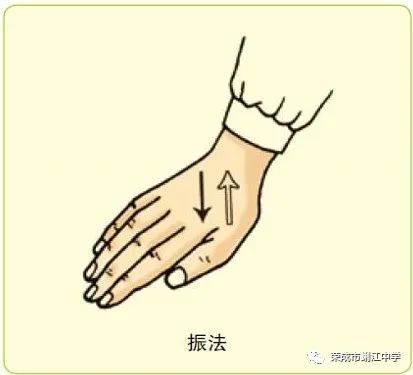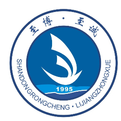Tui Na, a form of traditional Chinese medicine (TCM), is based on the theories of the internal organs (zangfu) and meridian system (jingluo) of TCM, combined with Western anatomical and pathological diagnostics. It employs manual techniques on specific areas of the body to regulate physiological and pathological conditions, achieving therapeutic goals. Essentially, it is a form of physical therapy.
In ancient times, Tui Na was referred to as massage or anmo, and it is one of the earliest health-preserving practices in China. The techniques of Tui Na have developed over more than five thousand years. During the Sui and Tang dynasties, positions such as massage doctors and therapists even emerged. The theoretical basis of Tui Na therapy is guided by the TCM theories of internal organs and meridians. When the flow of qi (气) and blood (血) through the meridians is smooth, the body remains healthy; when this flow is obstructed, diseases arise. Tui Na therapy can help to open the meridians and balance yin and yang, thus maintaining a healthy state.
Tui Na therapy is a treatment method that is universally applicable to the elderly, youth, children, and women. It has few side effects and a wide range of applications, serving as a common self-care method. It employs various techniques such as pushing (推), pulling (拿), pressing (按), rubbing (摩), kneading (揉), pinching (捏), tapping (拍), and point pressing (点) to achieve effects such as unblocking meridians, promoting qi and blood circulation, alleviating pain, dispelling pathogenic factors, and harmonizing yin and yang.
The techniques of Tui Na refer to the various skillful movements performed during the therapy. These techniques can stimulate the body’s meridian points or specific areas through many different forms of manipulation. Some techniques focus on pressing and pinching, such as pressing (按法), compressing (压法), point pressing (点法), pulling (拿法), pinching (捏法), and grasping (掐法); others focus on friction, such as flat pushing (平推法), rubbing (擦法), kneading (摩法), rolling (搓法), and massaging (揉法); some emphasize vibrating the limbs, such as tapping (拍击法), shaking (抖法), and pulling (运拉法); while others focus on moving the joints, such as rocking (摇法), pulling (扳法), and rolling (滚法). Below, we will introduce thirteen commonly used Tui Na techniques in TCM.
1. Pressing (按法)
Method: Use the palm’s root, thumb base, or elbow tip to apply pressure vertically downwards on the treatment area. Often combined with kneading, it is referred to as “press and knead” (按揉).
Key Points: ① Gradually increase pressure while pressing. ② When working on the back, press down in sync with the recipient’s exhalation, applying force momentarily.
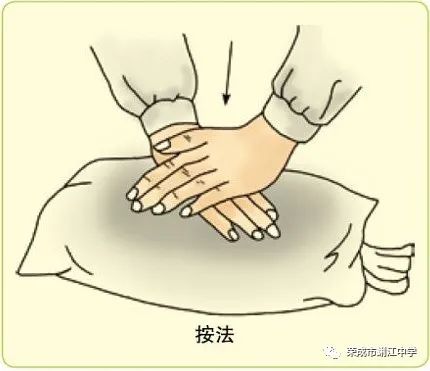
2. Kneading (揉法)
Method: ① Finger kneading: Use the fingertips to perform circular kneading on acupoints, applicable to all body parts. ② Palm kneading: Use the palm to perform circular kneading on acupoints, applicable to the waist, back, and abdomen. ③ Thenar kneading: Use the thenar eminence to perform circular kneading on acupoints, applicable to the face.
Key Points: ① Use the proximal part of the limb to drive the distal part in small circular motions, such as using the forearm to drive the wrist and palm for palm kneading. ② The pressure point should be firmly placed on the acupoint, engaging deeper tissues. ③ Maintain even pressure and coordinated rhythmic movements.
3. Pushing (推法)
Method: ① Palm pushing: Use the palm to apply linear pressure in one direction on the treatment area, applicable to the back, chest, abdomen, and lower limbs. ② Finger pushing: Use the fingers to apply linear pressure in one direction on the treatment area, applicable to tendon areas. ③ Thumb spreading: Place the radial sides of both thumbs on the forehead and push outward from the centerline of the forehead.
Key Points: ① The pressure point should be close to the skin, with moderate pressure—light but not floating, heavy but not stagnant. ② When pushing, the fingers should be in front, and the palm’s root behind. ③ Maintain a steady speed.
4. Rubbing (摩法)
Method: Use the palm or the surfaces of the index, middle, ring, and little fingers to contact the treatment area, moving in circular motions either clockwise or counterclockwise.
Key Points: ① The upper limb and wrist should be relaxed, lightly resting on the acupoint. ② Movements should be gentle and coordinated, with light pressure and a slow speed.
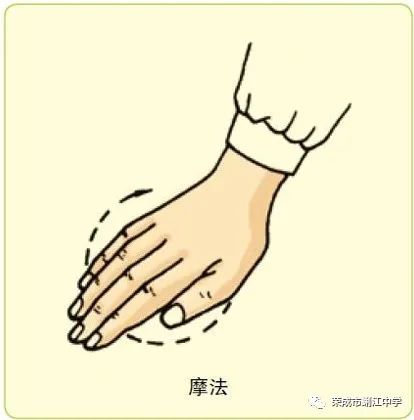
5. Scraping (擦法)
Method: ① Palm scraping: Use the palm to perform rapid back-and-forth linear scraping on the treatment area, applicable to the lower back, limbs, and shoulders. ② Thenar scraping: Use the thenar eminence to perform rapid back-and-forth linear scraping on the upper limbs and neck-shoulder area.
Key Points: ① Scraping should be done in a straight line, not at an angle. ② The pressure point should be close to the skin, with moderate pressure. ③ Movements should be continuous, with a fast and even speed, maximizing the distance of back-and-forth movements.
6. Grasping (拿法)
Method: Use the thumb and the other four fingers in opposition to apply rhythmic pinching on the treatment area, often combined with other techniques, applicable to the neck, shoulders, and limbs.
Key Points: ① The forearm should be relaxed, and the palm should be empty. ② When pinching, the direction should be perpendicular to the muscle belly, primarily using the metacarpophalangeal joints, with the interphalangeal joints remaining still. ③ Movements should be fluid, with pressure increasing from light to heavy.
7. Pinching (捏法)
Method: ① Three-finger pinching: With both wrists slightly extended, the thumb is placed horizontally against the skin, while the index and middle fingers are positioned in front of the thumb on the skin, pinching the skin with three fingers, alternating as they move forward. ② Two-finger pinching: With both wrists slightly ulnar deviated, the index finger’s middle phalanx is placed radially against the skin, while the thumb is positioned in front of the index finger on the skin, pinching the skin with the thumb and index finger, alternating as they move forward.
Key Points: ① Pinching should be done in a straight line, not at an angle. ② The tightness of the skin during pinching should be appropriate.
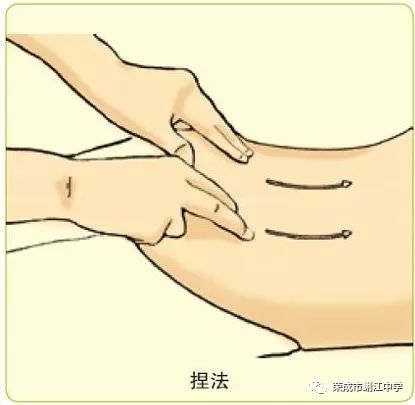
8. Tapping (击法)
Method: Use the fingertips to rhythmically and continuously tap the body surface, applicable to the head.
Key Points: ① The wrist should be relaxed, allowing the elbow joint to drive the wrist freely. ② Tapping should be elastic and rhythmic.

9. Point pressing (点法)
Method: Use the fingertip to apply sustained pressure on acupoints, which can also be applied momentarily.
Key Points: Maintain a certain posture with the fingers while applying pressure, avoiding excessive extension or flexion of the fingers to prevent injury.
10. Rubbing (搓法)
Method: Use both hands to grasp the limb and apply opposing rapid rubbing movements while simultaneously moving up and down, applicable to the upper limbs.
Key Points: ① The force should be symmetrical. ② Rubbing should be fast, while movement should be slow.
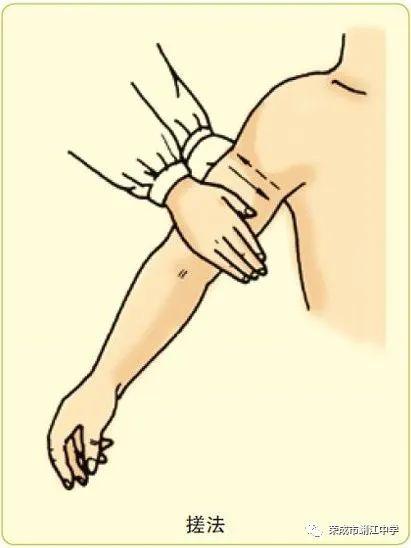
11. Twisting (捻法)
Method: Use the textured surface of the thumb and the radial edge of the index finger to grasp the treatment area, performing rapid up-and-down twisting movements, applicable to the fingers and ears.
Key Points: ① Twisting should be fast, while movement should be slow. ② The index finger should primarily drive the movement, with the thumb assisting. ③ Movements should be coherent.

12. Vibrating (拍法)
Method: With fingers together and slightly bent, use the forearm to freely flex and extend the wrist, allowing the fingers to strike first, followed by the wrist; when lifting, the wrist should rise first, followed by the fingers, lightly tapping the body surface.
Key Points: ① The tapping should be light. ② The wrist should move freely, and the elbow should flex freely. ③ Both hands can be coordinated.

13. Shaking (振法)
Method: ① Palm shaking: Place the palm on a specific area, performing continuous, rapid up-and-down vibrations, applicable to the abdomen and lower back. ② Finger shaking: Use the tips of the index and middle fingers on acupoints, performing continuous, rapid up-and-down vibrations.
Key Points: ① The pressure point should be close to the skin. ② The frequency should be fast, approximately 200-300 vibrations per minute.
